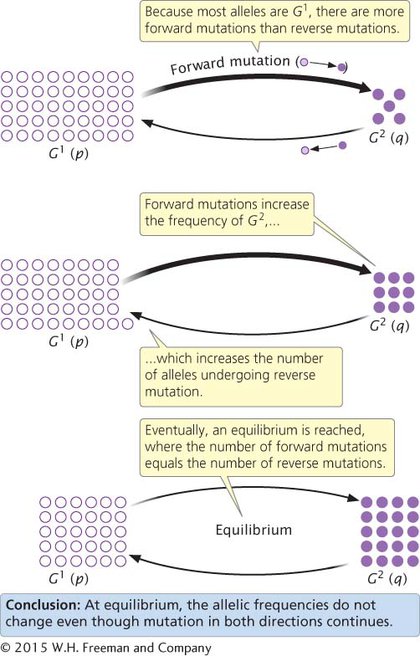Mutation
Before evolution can take place, genetic variation must exist within a population; consequently, all evolution depends on processes that generate genetic variation. Although new combinations of existing genes may arise through recombination in meiosis, all genetic variants ultimately arise through mutation.
THE EFFECT OF MUTATION ON ALLELIC FREQUENCIES Mutation can influence the rate at which one genetic variant increases at the expense of another. Consider a single locus in a population of 25 diploid individuals. Each individual possesses two alleles at the locus under consideration, so the gene pool of the population consists of 50 allele copies. Let’s assume that there are two different alleles, designated G1 and G2, with frequencies p and q, respectively. If there are 45 copies of G1 and 5 copies of G2 in the population, p = 0.90 and q = 0.10. Now suppose that a mutation changes a G1 allele into a G2 allele. After this mutation, there are 44 copies of G1 and 6 copies of G2, and the frequency of G2 has increased from 0.10 to 0.12. Mutation has changed the allelic frequencies.
If copies of G1 continue to mutate to G2, the frequency of G2 will increase and the frequency of G1 will decrease (Figure 18.3). The amount that G2 will change as a result of mutation depends on (1) the rate of G1-to-

So far, we have considered only the effects of G1 → G2 forward mutations. Reverse G2 → G1 mutations also occur, but at a rate that will probably differ from the forward mutation rate. Whenever a reverse mutation occurs, the frequency of G2 decreases and the frequency of G1 increases (see Figure 18.3).
REACHING EQUILIBRIUM Consider a population that begins with a high frequency of G1 and a low frequency of G2 (Figure 18.3a). In this population, many copies of G1 are initially available to mutate to G2, and the increase in G2 due to forward mutation will be relatively large. However, as the frequency of G2 increases as a result of forward mutations, fewer copies of G1 are available to mutate, so the number of forward mutations decreases. On the other hand, few copies of G2 are initially available to undergo a reverse mutation to G1, but as the frequency of G2 increases, the number of copies of G2 available to undergo reverse mutation to G1 increases; therefore, the number of genes undergoing reverse mutation will increase (Figure 18.3b). Eventually, the number of genes undergoing forward mutation will be counterbalanced by the number of genes undergoing reverse mutation (Figure 18.3c). At this point, the increase in q due to forward mutation will be equal to the decrease in q due to reverse mutation, and there will be no net change in allelic frequency, in spite of the fact that forward and reverse mutations continue to occur. A point at which there is no change in the allelic frequencies of a population is referred to as an equilibrium (see Figure 18.3c). At mutational equilibrium, the frequency of G2 is determined solely by the forward and reverse mutation rates.
SUMMARY OF EFFECTS When the only evolutionary force acting on a population is mutation, allelic frequencies change over time because some alleles mutate into others. Eventually, these allelic frequencies reach equilibrium and are determined only by the forward and reverse mutation rates.
The mutation rates for most genes are low, so change in allelic frequencies due to mutation in one generation is very small, and long periods are required for a population to reach mutational equilibrium. Nevertheless, if mutation is the only force acting on a population for long periods, mutation rates will determine allelic frequencies.
CONCEPTS
Recurrent mutation causes changes in the frequencies of alleles. At equilibrium, allelic frequencies are determined by forward and reverse mutation rates. Because mutation rates are low, the effect of mutation on allelic frequencies per generation is very small.